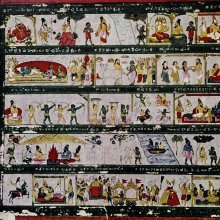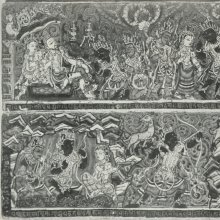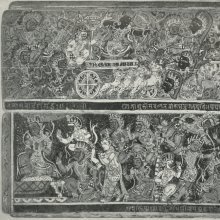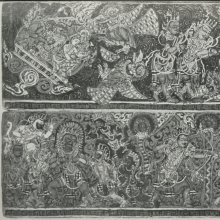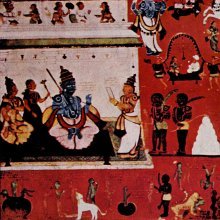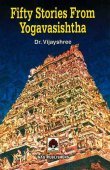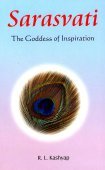Ramayana, Rāmāyaṇa: 19 definitions
Introduction:
Ramayana means something in Buddhism, Pali, Hinduism, Sanskrit, the history of ancient India, Marathi, Jainism, Prakrit. If you want to know the exact meaning, history, etymology or English translation of this term then check out the descriptions on this page. Add your comment or reference to a book if you want to contribute to this summary article.
Images (photo gallery)
(+69 more images available)
In Hinduism
Purana and Itihasa (epic history)
Source: archive.org: Puranic EncyclopediaRāmāyaṇa (रामायण).—General. Rāmāyaṇa is considered to be the first poetic composition in the world or at least in India, and hence it is called the Ādi Kāvya (First Epic). It is an epic as it contains descriptions and references to ancient themes. Vālmīki is its author, and hence Vālmīki is known as the 'Ādi kavi" also. Vālmīki and Śrī Rāma were contemporaries. During his life in exile in the forest Rāma visited Vālmīkī’s āśrama. It was in this āśrama that Sītā lived after being abandoned by Rāma. The connection in many ways of the life of Vālmīki with the 'Rāma story' was an incentive for him to write the Rāmāyaṇa. (See full article at Story of Rāmāyaṇa from the Puranic encyclopaedia by Vettam Mani)

The Purana (पुराण, purāṇas) refers to Sanskrit literature preserving ancient India’s vast cultural history, including historical legends, religious ceremonies, various arts and sciences. The eighteen mahapuranas total over 400,000 shlokas (metrical couplets) and date to at least several centuries BCE.
Vaishnavism (Vaishava dharma)
Source: Pure Bhakti: Brhad BhagavatamrtamRāmāyaṇa (रामायण) refers to:—The original epic history about Lord Rāmacandra and Sītā, written by Vālmīki Muni. (cf. Glossary page from Śrī Bṛhad-bhāgavatāmṛta).

Vaishnava (वैष्णव, vaiṣṇava) or vaishnavism (vaiṣṇavism) represents a tradition of Hinduism worshipping Vishnu as the supreme Lord. Similar to the Shaktism and Shaivism traditions, Vaishnavism also developed as an individual movement, famous for its exposition of the dashavatara (‘ten avatars of Vishnu’).
General definition (in Hinduism)
Source: Wisdom Library: HinduismRamayana is one of the two great Indian epics in Indian literature. It relates the life, activities, trials and achievements of Lord Rama. The great epic of Ramayana is traditionally attributed to Valmiki, who is considered to be the first poet of India. Ramayana presents the story of King Rama. The great epic comprises of 24000 couplets in seven books which give an account of the royal birth of Rama and his other three brothers, the loss of his throne and his victory over evil.
Source: WikiPedia: HinduismThe Ramayana is an ancient Sanskrit epic ascribed to the Hindu sage Valmiki and forms an important part of the Hindu canon (smṛti), considered to be based on historical events (itihāsa). The Ramayana is one of the two great epics of India, the other being the Mahabharata. It depicts the duties of relationships, portraying ideal characters like the ideal servant, the ideal brother, the ideal wife and the ideal king.
The Epic is traditionally divided into several major kāṇḍas or books, that deal chronologically with the major events in the life of Rama:
- Bāla Kāṇḍa (book of childhood)
- Ayodhya Kāṇḍa (book of Ayodhya)
- Araṇya Kāṇḍa (book of the forest)
- Kishkindha Kāṇḍa (book of the monkey kingdom)
- Sundara Kāṇḍa (book of beauty)
- Yuddha Kāṇḍa (book of war) also known as Lanka Kanda
- Uttara Kāṇḍa (last book)
In Buddhism
Theravada (major branch of Buddhism)
Source: Pali Kanon: Pali Proper NamesReference to this Epic Poem does not occur in the Pitaka or in the early books.
Even in the Commentaries reference thereto is rare (E.g., DA.i.76; MA.i.163, as Sitaharana), and then it is only condemned as purposeless talk (niratthakakatha).
Only in the later Chronicles, such as the Culavamasa (E.g. Cv.lxiv.42), is the work actually mentioned by name. See also Rama (5).
Theravāda is a major branch of Buddhism having the the Pali canon (tipitaka) as their canonical literature, which includes the vinaya-pitaka (monastic rules), the sutta-pitaka (Buddhist sermons) and the abhidhamma-pitaka (philosophy and psychology).
India history and geography
Source: Singhi Jain Series: Ratnaprabha-suri’s Kuvalayamala-katha (history)Rāmāyaṇa (रामायण) is the name of a work written by Vālmīki, as mentioned by Uddyotanasūri in his 8th-century Kuvalayamālā (a Prakrit Campū, similar to Kāvya poetry) narrating the love-story between Prince Candrāpīḍa and the Apsaras Kādambarī.—The Kuvalayamala (779 A.D.) is full of cultural material which gains in value because of the firm date of its composition. [...] On pages 3.18-4.12, Uddyotanasūri gives the names of a number of Kathās and their authors, in Sanskrit, Prakrit and Apabhramsha, [i.e., Vyāsa and Vālmīki to whom we owe Bhārata and Rāmāyaṇa], [...]—That was the usual practice of all writers like Subandhu, Bāṇa, Daṇḍin, Haribhadra, Svayaṃbhū etc. We are able to know the names of about fifty works including romances. Dr. A. N. Upadhye has dealt with these in his paper entitled “Works and Authors referred to in the Kuvalayamālā of Uddyotanasūri” submitted to the A.I.O.C. Session at Gauhati.

The history of India traces the identification of countries, villages, towns and other regions of India, as well as mythology, zoology, royal dynasties, rulers, tribes, local festivities and traditions and regional languages. Ancient India enjoyed religious freedom and encourages the path of Dharma, a concept common to Buddhism, Hinduism, and Jainism.
Languages of India and abroad
Marathi-English dictionary
Source: DDSA: The Molesworth Marathi and English Dictionaryrāmāyaṇa (रामायण).—n (S) An epic poem by Walmiki, recording the exploits and adventures of Rama. 2 A common name of several poems on the life and acts of Rama. 3 fig. A long story; a long yarn; any prolix and tedious tale. 4 Applied also in the sense of Litter, a disorderly strew; or a trampled or rumpled mass. Ex. hyā pōrānēṃ dhānyācēṃ āṇi kāgadāpatrācēṃ rā0 kēlēṃ; vāsana sōḍūna pāṅgharuṇāṃ- cyā ghaḍyāñcēṃ rā0 karūna ṭākalēṃ. tākāpuratēṃ rā0 (From a little story.) Service or performance according to the measure of the recompense.
Source: DDSA: The Aryabhusan school dictionary, Marathi-Englishrāmāyaṇa (रामायण).—n An epic poem by vālmīki. Fig. A long story.
Marathi is an Indo-European language having over 70 million native speakers people in (predominantly) Maharashtra India. Marathi, like many other Indo-Aryan languages, evolved from early forms of Prakrit, which itself is a subset of Sanskrit, one of the most ancient languages of the world.
Sanskrit dictionary
Source: Cologne Digital Sanskrit Dictionaries: Shabda-Sagara Sanskrit-English DictionaryRāmāyaṇa (रामायण).—n.
(-ṇaṃ) 1. The first epic poem of the Hindus, written by the poet Valmiki, recording the adventures of Rama, the son of Dasa Ratha, sovereign of Oudh. 2. A name of several poems on the life and adventures of Rama. E. rāma the prince, and ayana abode.
Source: Cologne Digital Sanskrit Dictionaries: Benfey Sanskrit-English DictionaryRāmāyaṇa (रामायण).—i. e. rāma-ayana (or rather + āyana), n. The name of a renowned epic poem, [Uttara Rāmacarita, 2. ed. Calc., 1862.] 110, 9.
Source: Cologne Digital Sanskrit Dictionaries: Cappeller Sanskrit-English DictionaryRāmāyaṇa (रामायण).—[feminine] ī relating to Rāma; [neuter] [Name] of an epic poem.
Source: Cologne Digital Sanskrit Dictionaries: Aufrecht Catalogus Catalogorum1) Rāmāyaṇa (रामायण) as mentioned in Aufrecht’s Catalogus Catalogorum:—See Adbhutarāmāyaṇa, Adhyātmarāmāyaṇa, Ānandarāmāyaṇa, Campūrāmāyaṇa, Vāsiṣṭharāmāyaṇa.
2) Rāmāyaṇa (रामायण):—by Vālmīki. Jones. 403. [Mackenzie Collection] 56. 102. Io. 1788-91. 1793. 2718 (Uttara). W. p. 118-23. Oxf. 5^b. 343^a. Paris. (B 20-22. 210. 222-24. D 2. 298. Gr. 11-13. Tel. 1. 43. 44. 48. 50). Khn. 24. K. 28 (and—[commentary]). B. 2, 64. 66. Report. Clxx. Ben. 57-59. Tu7b. 24. Kāṭm. 2. Pheh. 4 (Uttara). Rādh. 40. Oudh. Xi, 18. Xiii, 38. 40. Xv, 30. 32. Xvi, 52. 54. 56. Xvii, 14. Bonn. 125 -27. Burnell. 177^a. Bhk. 13. Poona. 363. 417. 425. Ii, 14. 15. 26. 27. 61-67. 81. 105-11. 264. Taylor. 1, 295. 296. Oppert. 8. 105. 604. 722. 917. 1104. 1556. 1558 (Uttara). 1642 (Sundara). 1705. 1724 (Sundara). 2012-14. 2147 (Yuddha). 2155 (Sundara). 2206. 2216 (Sundara). 2253. 2421. 2565 (Uttara). 2686. 2687. 2774 (Uttara). 2985. 3470. 3679. 3737. 3841. 4439. 6313 (Uttara). 6482 (Sundara). 6494 (Araṇya). 6652. 6779. 6837. 6988. 7117. 7146. 7383. 7571. 7628. 7776. Ii, 33 (Uttara). 224. 332 (Uttara). 353. 579. 662. 849. 977. 1368. 1418. 1504. 1699. 1802. 1844. 1903. 1940. 1986 (Bāla). 1996. 2141. 2168. 2200. 2516. 2573. 2592 (Uttara). 2612. 2640. 2668. 2680. 2684. 2698. 2853. 3013. 3249. 3385. 3474. 3529. 3598 (Uttara). 3784. 3899 (Sundara). 3933. 4348. 4428. 5124. 5780. 5821 (Uttara). 5999. 6141. 6177. 6403. 6551. 6637. 7031. 7237. 7332 (Sundara). 7438. 7481 (Ayodhyā). 7492 (Āraṇya). 7504 (Uttara). 7527 (Kiṣkindhā). 7650 (Bāla). 7716 (Yuddha). 7840 (Sundara). 8335. 8441. 8519. 8582. 8685. 8720 (Uttara). 8748 (Bāla). 8765 (Yuddha). 8791 (Sundara). 8935. 9085. 9506. 9646. 9749. 9791. 10062. 10071 (Sundara). 10174. 10354. Rice. 66. 68. Peters. 2, 186. Bp. 259 (Ayodhyā and Sundara). Proceed. Asb. 1869, 224.
—[commentary] Oppert. 4386. 4441. Ii, 337. 347.
—[commentary] Kataka. Burnell. 178^b. Oppert. 1780. 1781. Ii, 7482. 7513. 7723.
—[commentary] Caturarthadīpikā. Oppert. Ii, 7084.
—[commentary] Taniślokī. Oppert. 226. 6345. Ii, 934. 2049. 3153.
—[commentary] Tilaka Theh 4.
—[commentary] Rāmāyaṇavirodhaparihāra. Oppert. Ii, 5555.
—[commentary] Rāmāyaṇatātparyavirodhabhañjinī. Oppert. 1557. 5164. Ii, 2094.
—[commentary] Vālmīkihṛdaya. Oppert. 5348.
—[commentary] Vidvanmanoramā. Oppert. Ii, 7746.
—[commentary] Śṛṅgārasudhākara. Oppert. 6249.
—[commentary] Subodhinī. Oppert. Ii, 8985.
—[commentary] Setu. Pheh. 4.
—[commentary] by Īśvara Dīkṣita. Oppert. 5148. 5777 (ny). 6311 (vedānta). Ii, 7238. 7500. 8719.
—[commentary] by Umāmaheśvara. Oppert. Ii, 4885.
—[commentary] Śṛṅgāratilaka by Govindarāja. Oudh. Ix, 4 (Bhūṣaṇa). Xvi, 52. 54. 56 (Bhūṣaṇa). Oppert. 225. 378. 2015. 2315. 4460. 5147. 5423. 5524. 5784. 6331. 7297. Ii, 225. 339. 354. 2743. 3495. 3530. 5781. 6142. 6796. 7546. 8769. 10063. Rice. 68.
—[commentary] Dharmakūṭa by Tryambaka Yajvan. Burnell. 179^b.
—[commentary] by Devarāma Bhaṭṭa. Oudh. Xiii, 38. 40. Sb. 210.
—[commentary] by Nāgeśa. Ben. 58. 59. Rādh. 40. Oudh. Xi, 18.
—[commentary] by Nṛsiṃha. Taylor. 1, 141.
—[commentary] by Maheśvaratīrtha. Io. 1793. L. 1268. 1269. Oudh. Ix, 4. Bhk. 13. Poona. 417. 425. Ii, 14. 15. 27. 61-67. Taylor. 1, 296. Oppert. 5128. Ii, 9790. Peters. 2, 186.
—[commentary] Tilaka by Rāmavarman or Rāma Śarman. Io. 426-32. Burnell. 179^b. Oppert. Ii, 4886. Peters. 2, 186. His
—[commentary] is based on the Kataka and on that of Maheśvaratīrtha, whom he calls Tīrtha.
—[commentary] Rāmāyaṇakūṭaṭīkā by Rāmānandatīrtha. Oppert. 227. 1207. 6307. 6354. 6587. Mentioned L. 1017. By Oppert. attributed to Ānandatīrtha.
—[commentary] by Rāmānuja (?). Oppert. 231. 2689. 5149. 6177. Ii, 7724. Rice. 68. Perhaps, the
—[commentary] by Rāmavarman.
—[commentary] by Rāmāśramācārya. Oudh. Xv, 30. 32.
—[commentary] Manoharā by Lokanātha. L. 1259-62. Oppert. Ii, 7651.
—[commentary] Vivekatilaka by Varadarāja. Burnell. 179^b. Taylor. 1, 169. Oppert. 2986. Ii, 7754.
—[commentary] by Vidyānātha. Oppert. Ii, 8770.
—[commentary] Vālmīkitātparyataraṇi by Viśvanātha. Oudh. V, 6.
—[commentary] by Vaidyanātha. Burnell. 179^b. Oppert. 6177. Ii, 9750.
—[commentary] by Śivarāma Saṃnyāsin. Rādh. 40.
—[commentary] Rāmāyaṇasaptabimba by Hayagrīva Śāstrin Oppert. 370.
—[commentary] by Hari Paṇḍita. Oppert. 221. Ii, 7851. Rāmāyaṇe Ādityahṛdayastotra (Yuddhakāṇḍa ch. 106). Ben. 45. Burnell. 201^b. Taylor. 1, 427.
—Citrakūṭamāhātmya. [Mackenzie Collection] 71. Oudh. Viii, 36.
3) Rāmāyaṇa (रामायण):—by Vālmīki. Cu. add. 2108 (Araṇya). Gov. Or. Libr. Madras 77. Hz. 1. 75. 103. 115 (Uttara). 207 (2-7). 247 (Uttara). 318. 387 (Uttara). 460. 561. 594. Io. 426-32. 450 (Uttara). 1236 (Uttara). 1275-76 (1-5). 1381 (Bāla). 1588 (Uttara). 1788 (Bāla, Araṇya 1-3, Sundara up to 24, 18. Uttara [fragmentary]). 1789-92 (1-4). 2148-49. 2718 (Uttara adhy. 13-106). 2771 (Uttara). 2855 (up to Yuddha 61, 27). 2883 (Bāla and Ayodhyā). Oudh. Xx, 46 (Sundara). 56. Rgb. 123 (Ayodhyā).
—[commentary] [anonymous] Hz. 583. Io. 897 (on Sundara).
—[commentary] Caturarthī. Gov. Or. Libr. Madras 77.
—[commentary] Vidvanmanorañjanī. ibid.
—[commentary] Vālmīkihṛdaya by Ahobalācārya. Gov. Or. Libr. Madras 83.
—[commentary] by Govindarāja. ibid. (Maṇimañjīra on Bālakāṇḍa; Maṇimekhalā on Ayodhyākāṇḍa). Hz. 243 (Araṇya up to Sundara). 383 (Yuddha). 391 (Ayodhyā). 462 (Araṇya and Kiṣkindhā). 582 (3-6). Oudh. Xxi, 42 (Bhūṣaṇa). 44 (Bhūṣaṇa).
—[commentary] by Devarāma Bhaṭṭa. Stein 198 (Kiṣkindhā).
—[commentary] by Nṛsiṃha. Hz. 536 (Ayodhyā).
—[commentary] Virodhabhañjanī by Brahmavidyādīkṣita. Gov. Or. Libr. Madras 77. Hz. 305. 375. 583. Extr. 76.
—[commentary] Tattvadīpikā by Maheśvara Tīrtha. Gov. Or. Libr. Madras 30. 77. Hz. 7. 22 (Bāla). 217 (Ayodhyā). 653 (except Sundara). Io. 1275-76 (1-5). 1381 (Bāla). 1788 (Bāla, Araṇya 1-3, Sundara up to 24, 8. Uttara [fragmentary]). 2148 -49. Stein 197 ([fragmentary]).
—[commentary] by Rāmacandra Sarasvatī. Quoted in his Bhagavadgītāṭīkā, Hz. Extr. 59.
—[commentary] by Rāmacandrānanda Sarasvatī. Hz. 239 (Sundara).
—[commentary] Tilaka by Rāmavarman or Rāma Śarman. Io. 426-32. 1789-92. Stein 198.
—[commentary] by Rāmānuja. Gov. Or. Libr. Madras 77 (Sundara).
—[commentary] Manoharā by Lokanātha. Io. 816 (5-7).
—[commentary] by Vimalabodha Quoted by Lokanātha, L. 1259.
—[commentary] by Sarvajña Quoted by Lokanātha, L. 1259. Rāmāyaṇe Citrakūṭayātrā. Peters. 4, 13.
—Saṃkṣiptarāmāyaṇa. Stein 198.
4) Rāmāyaṇa (रामायण):—Ulwar 861. 862 (and—[commentary]).
5) Rāmāyaṇa (रामायण):—Ak 224 (without the Yuddhakāṇḍa). 225 (Kiṣkindhākāṇḍa inc.). 226 (Kiṣkindhākāṇḍa and C.). 227 (Sundarakāṇḍa and C. inc.). As p. 163. Bc 93. Bd. 176 (Ayodhyākāṇḍa). Cs 4, 185. 186 (Araṇyakāṇḍa). 187 (Bālakāṇḍa). 188 (Ayodhyākāṇḍa). 189 (Kiṣkindhākāṇḍa). 224 (Uttarakāṇḍa). 305 (dto. inc.). 307 (inc.). Hz. 679. L.. 191 (Bālakāṇḍa). 192 (Bālakāṇḍa inc.). 193 (Sundarakāṇḍa). 194 and 195 (Yuddhakāṇḍa). 196 (Uttarakāṇḍa). Śg. 1, 37 (Sundarakāṇḍa). 2, 282 (Uttarakāṇḍa). Whish 54 (without Uttarakāṇḍa). 56 (Uttarakāṇḍa. C. [anonymous] Whish 55, 1 (as far as 1, 1, 83). C. Kataka, correctly Amṛtakataka. Bc 295. 415 (Bālakāṇḍa). 438. Hz. 1496 (Sundarakāṇḍa). Śg. 1, 38 ([fragmentary]). 2, 284 (Araṇyakāṇḍa). C. Taniślokī, a C. on select verses. Hz. 718. C. by Govindarāja. Bd. 176 (Araṇyakāṇḍa). C. Viṣamapadavyākhyā by Devarāma Bhaṭṭa. Cs 4, 190. C. Tattvadīpikā by Maheśvaratīrtha. As p. 164. C. by Rāmānuja. Śg. 2, 283. Whish 10 (Bālakāṇḍa and Ayodhyākāṇḍa). 63 (Araṇyakāṇḍa, Kiṣkindhākāṇḍa and chapters 1-3 of the Sundarakāṇḍa). 68 (Yuddhakāṇḍa). C. Manoharā by Lokanātha. As p. 164. C. by Veṅkaṭeśa. Bc 13. Rāmāyaṇe Ādityahṛdayastotram. L.. 197, 1. Bṛhadrāmāyaṇe Citrakūṭamāhātmyam. Hpr. 2, 64.
Source: Cologne Digital Sanskrit Dictionaries: Monier-Williams Sanskrit-English Dictionary1) Rāmāyaṇa (रामायण):—[from rāma] a See rāmāyaṇa, [column]3.
2) [from rāma] b mf(ī)n. relating to Rāma (Dāśarathi), [Śārṅgadhara-paddhati]
3) [from rāma] n. (ramāyaṇa) Name of Vālmīki’s celebrated poem, describing the ‘goings’ ([ayana]) of Rāma and Sitā (it contains about 24000 verses in 7 books called Kāṇḍas, viz. 1. Bāla-kāṇḍa or Ādi-k°; 2. Ayodhyā-k°; 3. Araṇya-k°; 4. Kiṣ-kindhyā-k°; 5. Sundara-k°; 6. Yuddha-k°; 7. Uttara-k°; part of the 1st book and the 7th are thought to be comparatively modern additions; the latter gives the history of Rāma and Sītā after their re-union and installation as king and queen of Ayodhyā, afterwards dramatized by Bhava-bhūti in the Uttara-rāma-caritra; Rāma’s character, as described in the Rāmāyaṇa, is that of a perfect man, who bears suffering and self-denial with superhuman patience; the author, Vālmīki, was probably a Brāhman connected with the royal family of Ayodhyā; and although there are three recensions of the poem, all of them go back to a lost original recension, the ground work of which, contained in books 2-6, in spite of many amplifications and interpolations, may be traced back to one man, and does not like the Mahābhārata, represent the production of different epochs and minds), [Mahābhārata; Harivaṃśa] etc. (cf. [Indian Wisdom, by Sir M. Monier-Williams 335]).
Source: Cologne Digital Sanskrit Dictionaries: Yates Sanskrit-English DictionaryRāmāyaṇa (रामायण):—[rāmā+yaṇa] [(ṇaṃ)] 1. n. An epic poem of the Hindus celebrating Rāṃchandra.
Source: DDSA: Paia-sadda-mahannavo; a comprehensive Prakrit Hindi dictionary (S)Rāmāyaṇa (रामायण) in the Sanskrit language is related to the Prakrit word: Rāmāyaṇa.
[Sanskrit to German]
Sanskrit, also spelled संस्कृतम् (saṃskṛtam), is an ancient language of India commonly seen as the grandmother of the Indo-European language family (even English!). Closely allied with Prakrit and Pali, Sanskrit is more exhaustive in both grammar and terms and has the most extensive collection of literature in the world, greatly surpassing its sister-languages Greek and Latin.
Prakrit-English dictionary
Source: DDSA: Paia-sadda-mahannavo; a comprehensive Prakrit Hindi dictionaryRāmāyaṇa (रामायण) in the Prakrit language is related to the Sanskrit word: Rāmāyaṇa.
Prakrit is an ancient language closely associated with both Pali and Sanskrit. Jain literature is often composed in this language or sub-dialects, such as the Agamas and their commentaries which are written in Ardhamagadhi and Maharashtri Prakrit. The earliest extant texts can be dated to as early as the 4th century BCE although core portions might be older.
Kannada-English dictionary
Source: Alar: Kannada-English corpusRāmāyaṇa (ರಾಮಾಯಣ):—[noun] one of the two great epics of India, written in Saṃskřta by sage Vālmīki (later by many in different languages) that is connected with the life, ideals of Rāma.
Kannada is a Dravidian language (as opposed to the Indo-European language family) mainly spoken in the southwestern region of India.
See also (Relevant definitions)
Starts with (+18): Ramayanabharatasarasamgraha, Ramayanacampu, Ramayanachampu, Ramayanakalanirnayacandrika, Ramayanakatha, Ramayanakathaprashna, Ramayanakathasara, Ramayanakathasaramanjari, Ramayanakutatika, Ramayanam, Ramayanamahatmya, Ramayanamahimadarsha, Ramayanamanjari, Ramayananataka, Ramayananavahaparayanamahatmya, Ramayananirvacana, Ramayanapathanaphala, Ramayanaprabandha, Ramayanaprasangaratnavali, Ramayanapurana.
Ends with (+21): Abhinavacampuramayana, Adbhutaramayana, Adhyatmaramayana, Amararamayana, Anandaramayana, Arsharamayana, Arsheyaramayana, Aryaramayana, Ashcaryaramayana, Balaramayana, Bhavishyaramayana, Campuramayana, Champuramayana, Chandoramayana, Chhandoramayana, Citrabandharamayana, Gayatriramayana, Hanumadramayana, Kaviramayana, Kriyagopanaramayana.
Full-text (+15194): Valmiki, Kavijyeshtha, Ramayanam, Taliyaka, Kamparamayanam, Lakshmana, Hanuman, Ikshvaku, Pariprapti, Pratijivana, Samyodhakantaka, Tamropajivin, Gharsha, Kalmashapada, Marica, Rishyashringa, Vanara, Vidarshin, Adbhutottarakanda, Kalakankshin.
Relevant text
Search found 178 books and stories containing Ramayana, Rāmāyana, Rāmāyaṇa; (plurals include: Ramayanas, Rāmāyanas, Rāmāyaṇas). You can also click to the full overview containing English textual excerpts. Below are direct links for the most relevant articles:
Garga Samhita (English) (by Danavir Goswami)
Verse 2.13.16 < [Chapter 13 - The Story of Śeṣa]
Verse 4.19.85 < [Chapter 19 - A Thousand Names of Srī Yamunā]
Mareecha in Valmiki and Adhyatma Ramayana < [October – December, 2003]
The Ramayana Tradition in Asia < [July – September, 1984]
Birth Episode of Sita in Adhyathma Ramayana < [October – December, 2001]
Bhakti-rasamrta-sindhu (by Śrīla Rūpa Gosvāmī)
Verse 2.5.127 < [Part 5 - Permanent Ecstatic Mood (sthāyī-bhāva)]
Verse 2.5.126 < [Part 5 - Permanent Ecstatic Mood (sthāyī-bhāva)]
Animal Kingdom (Tiryak) in Epics (by Saranya P.S)
Chapter 3.4 - The story of Jambavan (Immortal characters, part 1)
Chapter 4.20 - Animals and birds in the epic Ramayana (Introduction)
Brihad Bhagavatamrita (commentary) (by Śrī Śrīmad Bhaktivedānta Nārāyana Gosvāmī Mahārāja)
Verse 1.4.56 < [Chapter 4 - Bhakta (the devotee)]
Verse 1.4.46 < [Chapter 4 - Bhakta (the devotee)]
Verse 1.4.40 < [Chapter 4 - Bhakta (the devotee)]
Hanuman Nataka (critical study) (by Nurima Yeasmin)
Part 4: Some important Plays based on the Rāmāyaṇa < [Chapter 1]
Source of the Plot < [Chapter 3]
Deviation from the Original < [Chapter 3]
Related products
(+6 more products available)
